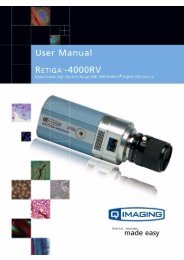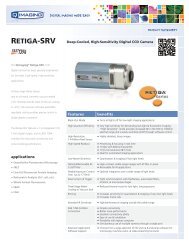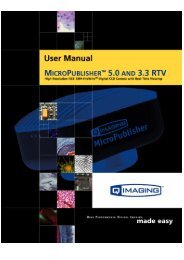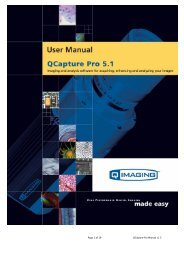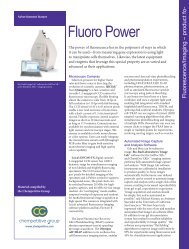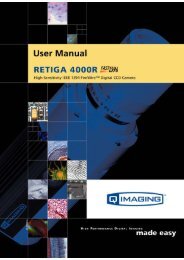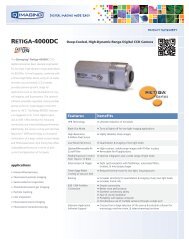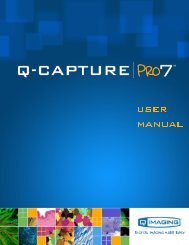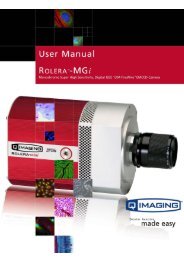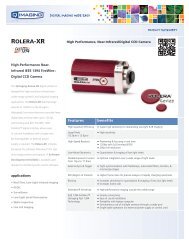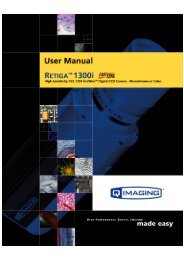Rolera EM-C 2 User Manual - QImaging
Rolera EM-C 2 User Manual - QImaging
Rolera EM-C 2 User Manual - QImaging
- No tags were found...
You also want an ePaper? Increase the reach of your titles
YUMPU automatically turns print PDFs into web optimized ePapers that Google loves.
<strong>Rolera</strong> <strong>EM</strong>-C 2 <strong>User</strong>’s <strong>Manual</strong>ApplicabilityThis document applies to the <strong>Rolera</strong> <strong>EM</strong>-C 2 camera. For the latest updates, please visitWWW.QIMAGING.COM.Notice of CopyrightCopyright © 1999-2010 Quantitative Imaging Corporation. All rights reserved. Unauthorizedduplication of this document is prohibited.Trademarks and Proprietary Names<strong>QImaging</strong>, <strong>Rolera</strong>, Retiga, QICAM, MicroPublisher, Go, LightWire-800, Fast-1394, and QCapture aretrademarks of <strong>QImaging</strong>. Product names mentioned in this document may be trademarks orregistered trademarks of <strong>QImaging</strong> or other hardware, software, or service providers and are usedherein for identification purposes only. Microsoft® and Windows® are registered trademarks in theU.S. and other countries of Microsoft Corporation and are used herein for identification purposesonly. Apple® and Macintosh® are registered in the U.S. and other countries by Apple Computer,Inc. and are used herein for identification purposes only.<strong>QImaging</strong> Corporation Address Information19535 56th Avenue, Suite 101Surrey, BCCanada V3S 6K3WWW.QIMAGING.COM<strong>QImaging</strong> Technical SupportTechnical support is available to all registered users of <strong>QImaging</strong> products from 7am to 5pm PacificStandard Time.SUPPORT@QIMAGING.COM604.708.5061WWW.QIMAGING.COM/SUPPORT/CONTACT/i
CONTENTS<strong>Rolera</strong> <strong>EM</strong>-C 2 <strong>User</strong>’s <strong>Manual</strong> ............................................................................................ iINTRODUCTION ............................................................................................................. 1Power Requirements ................................................................................................... 1Host Requirements ...................................................................................................... 1IEEE 1394 (FireWire) Interface ................................................................................. 2Cables..........................................................................................................................2Imaging Software for Your Camera ........................................................................... 3INSTALLATION .............................................................................................................. 4Step 1. Install the 1394 PCI-Express card (Windows <strong>User</strong>s Only) ............................ 4Step 2. Install Your Imaging Software ....................................................................... 5Step 3. Connect the <strong>Rolera</strong> <strong>EM</strong>-C 2 .............................................................................. 5CAMERA BASICS ........................................................................................................... 7Turning the Camera On and Off ................................................................................. 7Connecting the <strong>Rolera</strong> <strong>EM</strong>-C 2 to your Optics .............................................................7Understanding the LED Indicators ............................................................................. 8Capturing Images with the <strong>Rolera</strong> <strong>EM</strong>-C 2 ................................................................... 8ADVANCED CAMERA CONTROLS ............................................................................. 9Cooling Capability ...................................................................................................... 9Triggering the <strong>Rolera</strong> <strong>EM</strong>-C 2 Externally .................................................................... 9Gain and Offset Controls ........................................................................................... 11Easy-<strong>EM</strong> Mode……………....................................................................................... 11CARING FOR YOUR CAMERA .................................................................................... 12TROUBLESHOOTING .................................................................................................... 13Resolving Problems with the camera ......................................................................... 13Unresolved Problems - Contacting <strong>QImaging</strong> Support ............................................. 14GLOSSARY ..................................................................................................................... 15APPENDICES .................................................................................................................. 17APPENDIX A: External Trigger Port ....................................................................... 17ii
INTRODUCTIONCHAPTER 1The <strong>QImaging</strong>® <strong>Rolera</strong> <strong>EM</strong>-C 2 unites the highest sensitivity of <strong>EM</strong>CCD sensors with high resolution and highspeed. The camera's 1004 x 1002 frametransfer <strong>EM</strong>CCD provides QE up to 65%, enabling a1MegaPixel resolution for low-light imaging. With its ability to capture images at an unprecedented34.2full frames per second in 14-bit mode (and as fast as 200+ frames per second with binning andROI), the <strong>Rolera</strong> <strong>EM</strong>-C 2 sets a new benchmark in high-speed, high-sensitivity performance for live-cellconfocal microscopy.Power RequirementsThe <strong>Rolera</strong> <strong>EM</strong>-C 2 can be powered through a single IEEE 1394 FireWire 6-pin to 9-pin or 9-pin to 9-pin cable when the cooling is off. When the cooling is on, the <strong>Rolera</strong> <strong>EM</strong>-C 2 must be connected to theincluded external power supply.• Power Supply Specifications:Input Power:Output Power:100-240 VAC50-60Hz12VDC, 5A (60W)Host RequirementsFor Windows PCs:• Processor running at 1GHz or higher.• 256 MB RAM (512MB RAM preferred).• Video card with 16MB video memory capable of 32-bit color output.• Windows XP, Windows Vista, Windows 7• The included IEEE1394B FireWire card must be installed.1
For Mac OS Computers:• Intel based Macintosh computers with an OHCI compliant IEEE 1394B port.• Mac OS X 10.5 and above.• 256 MB+ RAM• The included IEEE 1394B card should be installed when a 1394b port is not present.IEEE 1394 (FireWire) InterfaceThe <strong>Rolera</strong> <strong>EM</strong>-C 2 can be powered and controlled through an IEEE 1394a or 1394b (FireWire)digital interface. To realise the full benefits of the <strong>Rolera</strong> <strong>EM</strong>-C 2 , a single FireWire connection from thecamera to the computer combined with the external power connection will allow full control of thecamera and rapid image data transfer from the camera to the computer. Maximum frame rates at14-bit will require a 1394b connection to exist on the computer and the supplied card can be used toensure full performance through the FireWire interface.CablesA 3-meter FireWire 9-pin to 9-pin interface cable is included with the camera. The 9-pin connectionof either cable must be connected to the available FireWire 1394b port at the back of the camera; theother end of the cable plugs into your computer’s 9-pin FireWire port. <strong>QImaging</strong> recommends thatyou install the supplied 1394B PCI-Express card to ensure proper connection to the 1394b port andexperience the full benefits of the camera.Some computers have 4-pin FireWire ports. These ports may be used if they are OHCI compliant, butyou will need to purchase a 4-pin to 9-pin FireWire cable from your local computer store. Whenconnecting the <strong>Rolera</strong> <strong>EM</strong>-C 2 to any FireWire port, you will need to use an external power supply.What is the difference between 4-pin, 6-pin and 9-pin FireWire ports?FireWire cables are available in three varieties: 4-pin, 6-pin and 9-pin. 9-pin and 6-pin FireWire cablesare capable of providing both power and a communication interface between the camera andcomputer while 4-pin cables provide only a communication interface. Some laptop computers have6-pin FireWire jacks that do not provide power. If your computer has such a port, you will have topower your <strong>Rolera</strong> <strong>EM</strong>-C 2 by attaching the included external power supply to the system.2
Imaging Software for Your CameraIndustry Standard Imaging ApplicationsThe <strong>Rolera</strong> <strong>EM</strong>-C 2 works with industry-standard Windows and Mac OS imaging software.QCapture Suite SoftwareThe <strong>Rolera</strong> <strong>EM</strong>-C 2 operates on both Windows and Mac OS based systems. QCapture Suite Softwarefor both systems is available at WWW.QIMAGING.COM. The easy-to-use QCapture software gives youcomplete control over the camera’s settings and image capture functions. QCapture Suite alsoincludes a TWAIN-compliant interface that allows many Windows image-editing applications toacquire images using <strong>QImaging</strong> cameras.3
INSTALLATIONCHAPTER 2IMPORTANT: Follow these steps in order to complete the installation.DO NOT CONNECT the camera until the camera driver is installed.1. Windows PC users only: Install the IEEE 1394 PCI-Express card - only if necessary.2. Imaging Software - Install the software and drivers that your new <strong>QImaging</strong>camera needs to capture images.3. <strong>Rolera</strong> <strong>EM</strong>-C 2 - Connect the camera to your computer using the included IEEE 1394 cable.DO NOT CONNECT the camera until you have a functioning FireWire port inyour computer and the camera driver is installed.Step 1. Install the 1394 PCI-Express card (Windows<strong>User</strong>sOnly)This step is for Windows PC users only. If you are installing the <strong>Rolera</strong> <strong>EM</strong>-C 2computer, please skip to Step 2.on a Mac OSCheck your computer for an existing FireWire port:The <strong>Rolera</strong> <strong>EM</strong>-C 2 connects to your Windows PC via a FireWire port. If you already have a FireWireport, you may not have to install the IEEE 1394 PCI-Express card. Check the connectors at the backof your PC for a port that matches the FireWire port of the connection shown in Figure 1 or Figure2.CameraComputerFigure 1 — 9-pin to 9-pin FireWire (IEEE 1394) Port connection (recommended)If your PC does not have a functioning FireWire port, you must install the IEEE 1394 PCI-Express cardthat came with your camera.If necessary, install the included IEEE 1394 PCI-Express card:• Shut down your computer.• Open the case, and install the included IEEE 1394 card into an empty PCI slot. See the user’smanual for your computer for complete instructions on installing new PCI-Express cards.• Restart your computer. Windows should automatically install the appropriate softwaredrivers for the card.4
Step 2. Install Your Imaging SoftwareOnce the IEEE 1394 card is installed in your computer, you are ready to install the FireWire drivers andimaging software. See your Imaging Software <strong>User</strong>’s Guide for complete installation instructions.Step 3. Connect the <strong>Rolera</strong> <strong>EM</strong>-C 2Once your imaging software is installed, connect your camera. For the <strong>Rolera</strong> <strong>EM</strong>-C 2 , in order tooperate the cooling, the camera must have the external power connected. However, should thecooling not be required, a single 9-pin to 9-pin connection will operate the camera sufficiently.In most cases, the FireWire cable provides the necessary power required by the <strong>Rolera</strong> <strong>EM</strong>-C 2 .However, if your camera is cooled you will need to provide additional power to the camera as shownin Figure 5.Connecting the <strong>QImaging</strong> CameraPerform the following for connecting your camera.• Remove the FireWire cable from the camera box, and plug one end of the cable into thecamera’s FireWire socket.Figure 3 — Camera FireWire Socket.5
• Plug the other end of the cable into a FireWire port on your computerCameraComputerFigure 4 — Desktop Computer FireWire Connection• In order to obtain the cooling specification of the camera, the supplied external poweradapter needs to be connected to the camera as shown in Figure 5 below.ComputerCamera110/240 VACpower supplyFigure 5 — FireWire and External Power Supply Connection• If you have a laptop computer, you can use the built in FireWire port or a PCMCIA card.However, should you connect to a laptop computer you will still be required to connect thesupplied external power supply to the camera in order to power it.6
CAMERA BASICSCHAPTER 3The <strong>Rolera</strong> <strong>EM</strong>-C 2 ’s image capture capabilities are controlled entirely by your imaging software.This chapter provides basic instructions for working with the camera itself.Turning the Camera On and OffTo turn the <strong>Rolera</strong> <strong>EM</strong>-C 2 on, press the power switch. The <strong>Rolera</strong> <strong>EM</strong>-C 2 lights will flash and thewhite power light will remain on, provided that you have the appropriate configuration of “Step 3”in the “Introduction” section. Refer to this step for all system configurations ensuring that theFireWire cable(s) are connected as specified. If power is supplied, the WHITE LED will turn on.To turn the <strong>Rolera</strong> <strong>EM</strong>-C 2 off, press the power switch again. This will turn your camera off. TheWHITE LED will turn off.POWER SIWTCHFigure 6 — Power Switch on the <strong>Rolera</strong> <strong>EM</strong>-C 2Connecting the <strong>Rolera</strong> <strong>EM</strong>-C 2 to your OpticsThe <strong>Rolera</strong> <strong>EM</strong>-C 2 connects directly to widely available C-mount optics, which are standard onmost microscopes and lenses.To attach the camera to a microscope:Carefully thread the camera onto the microscope’s C-mount adapter, rotating the camera until it ismounted securely. Use the microscope controls to adjust focus.To attach a C-mount lens to the camera:Carefully thread the C-mount lens onto the camera’s lens ring, rotating the lens in a clockwisedirection until it is mounted securely. Use the lens controls to adjust focus.7
To attach F-mount optics:If you purchased the optional color filter, then carefully thread the color filter to the C-mount ringon the camera. The opposite end of the color filter is a female F-mount connector. Carefullyconnect your F-mount optics to the open connector of the color filter until it is mounted securely.Use your optics controls to adjust focus.NOTE: If you did not purchase a color filter, then you will need to purchase a C to F mount adapterto allow the connection of F-mount optics. Your camera does not need to be monochrome in thissituation.Understanding the LED IndicatorsThe LED indicators at the back of the camera give you important information about what your camerais doing:• WHITE: The white LED is the power indicator. This LED should always be lit when thecamera is connected to your computer and is turned on.• GREEN: The green LED is the exposure/integration indicator. It will stay illuminated forthe duration of the exposure of the CCD and turn off when not exposing.• BLUE: The blue LED is the cooling indicator. It will flash while cooling down to theset temperature. When the temperature is locked and regulated, the blue LEDwill stay illuminated. It will turn off when cooling is turned off throughsoftware.Capturing Images with the <strong>Rolera</strong> <strong>EM</strong>-C 2Consult your imaging application’s user’s manual for more details.8
CHAPTER 4ADVANCED CAMERA CONTROLSThe <strong>Rolera</strong> <strong>EM</strong>-C 2 offers many advanced features. This section provides information on how to make themost of your <strong>QImaging</strong> camera.Cooling CapabilityThe <strong>Rolera</strong> <strong>EM</strong>-C 2 offers the user the option of selecting the cooling temperature in one (1)degree increments. The maximum cooling of the <strong>Rolera</strong> <strong>EM</strong>-C 2 is -50ºC.Triggering the <strong>Rolera</strong> <strong>EM</strong>-C 2 ExternallyExternally triggering the <strong>Rolera</strong> <strong>EM</strong>-C 2 provides a sophisticated method of imaging andsynchronizing your camera to external parts of your system, offering advanced capabilities. To usethis feature effectively, it is important to understand the operation and configuration of yourcamera.The External Trigger Port of the <strong>Rolera</strong> <strong>EM</strong>-C 2 is a 6-pin miniature circular DIN connector. This portaccepts digital logic signals that are used to control the camera's integration. The External Trigger Portis optically isolated from the camera's electronics. For this reason, the user must provide power to theExternal Trigger Port. See Appendix A for a pinout and schematic diagram of the External Trigger Port.In externally triggered modes of operation, the user inputs a pulse on the External Trigger Port thatcontrols the camera's integration in one of two ways depending on the triggering mode.Triggering ModesWhen using External Triggering, there are three different types of triggering modes: Edge High/Low,Pulse High/Low and Strobe High/Low.Edge mode:Pulse Mode:allows the camera to start integrating on the rising or falling edge of the triggerpulse with the integration time controlled internally by the camera. Using thismethod allows you to externally trigger the camera as fast as possible, andallows you to take advantage of the simultaneous readout and exposurefunction.allows the user to control the integration period where the time is dictated bythe duration of the pulse. If “Pulse High” mode is used, then the time the pulseis high is the time of the integration period. Vice versa for “Pulse Low” mode.This mode does not allow the simultaneous readout and exposure operation ofthe camera.Strobe Mode: allows the user the combination of pulse mode with simultaneous readout andexposure. This is a very advanced mode of operation of the camera such that thesecond pulse must finish after the readout of the first. The time between pulsesis very critical for this operation9
Connecting External Sources to the CameraBefore you can begin to externally trigger your camera, you need to connect the necessary triggersignal source to the camera. To do this you need to ensure that you have a 6-pin miniature circulardin cable and ensure that the pinouts are set correctly from your trigger source. Refer to Appendix Afor further details on pin assignments and a diagram of the mini-din connector.There are several ways that you can provide an external pulse to the camera, one of them being viathe <strong>QImaging</strong> External Trigger Box, which is available through <strong>QImaging</strong>, and another commondevice is a function generator. To trigger the camera, you need to provide a 5V TTL pulse though thepin stated in Appendix A.To ensure that you will use the external triggering mechanism correctly, it is important to ensure thatthe following questions have been answered when devising or architecting your system design:• Has a system design been developed that incorporates the necessary elements such as:• a Timing Diagram,• Flow of Events (e.g. a simple state diagram),• necessary components (e.g. microscope, flash lamp, shutter etc),• a software solution for extracting and/or processing your images,• External Triggering source (e.g. <strong>QImaging</strong> Trigger board, function generator etc)• Have you Determined the type of triggering mode you require for you application?• Are you sure the settings in the camera have been set correctly. For instance, are youmonitoring the SYNCB output and if so have you set the correct output mode for yoursystem?The above list should be used as a guide and should be consulted before contacting <strong>QImaging</strong>Technical Support.Trigger Mode Trigger Source Exposure ControlContinual Internal to Camera Internal to CameraEdge Hi/Lo External Trigger Port Internal to CameraPulse Hi/Lo External Trigger Port Length of <strong>User</strong> PulseStrobe Hi/Lo External Trigger Port Length of <strong>User</strong> PulseSoftware QCAM API Trigger Event Internal to CameraTable 1—Trigger Sources and Integration Modes10
Gain and Offset ControlsThe <strong>Rolera</strong> <strong>EM</strong>-C 2 has two gain modes: (1) Multiplication Gain or <strong>EM</strong> Gain and (2) Easy-<strong>EM</strong> mode.The Multiplication gain controls the <strong>EM</strong> portion of the camera and allows you to bring the signal ofthe sample above the read-noise.The offset control of the <strong>Rolera</strong> <strong>EM</strong>-C 2 allows you to change your bias level or offset level to ensurethat you capture all signals. This mapping is performed in the analog domain and thus avoids thequantization errors incurred when the mapping is performed in the digital domain.Easy-<strong>EM</strong> ModeThe <strong>Rolera</strong> <strong>EM</strong>-C 2 introduces the new Easy-<strong>EM</strong> Mode. This mode optimizes the <strong>EM</strong> Gain setting on thecamera to provide the best signal to noise ratio.Using <strong>EM</strong> Gain adds an additional noise source known as Excess Noise. Using too much <strong>EM</strong> Gain willincrease this Excess Noise being added to the signal. However, using too little <strong>EM</strong> Gain does noteffectively reduce the read-noise.Easy-<strong>EM</strong> Mode automatically selects the optimal position for the <strong>EM</strong> Gain to maximize the quality of yourresults. Each and every camera is individually tested and calibrated to provide optimal settings.11
CARING FOR YOUR CAMERACHAPTER 5The <strong>Rolera</strong> <strong>EM</strong>-C 2 camera requires no regular maintenance except occasional external cleaning of thecooling window (the glass window that forms part of the cooling chamber and sits between thecamera sensor and the microscope or lens).To c l e a n the Cooling window:CAUTION — The camera’s Cooling windows, CCD sensor, and circuits aresensitive to static discharge. Ensure you are using a static strap or arecompletely grounded at all times to release any static energy before youclean the cooling window.• Use clean forced air (available at stores that sell cameras and computer cleaning supplies)to dust the cooling window (recommended).• If the image still appears dirty, gently wipe the face of the cooling window with a smallamount of optical grade isopropyl alchohol and lens paper.• Apply forced air again to remove any loose particles.12
TROUBLESHOOTINGCHAPTER 6Resolving Problems with the cameraThe White LED is not lit.• Check all the cable connections.• Press the switch at the back of the camera.• If your white LED is still not lit, then your camera may not be receiving the required power.If you have a 1394 Power Supply or the included external power supply, connect thecamera as listed in Step 3 of the “Introduction” Section.Image occasionally goes bright on one side or stays dark on one sideTurn off the overhead lights in the room. Fluorescent lights may interact with the camera to createfluctuating image brightness.Hazy image or poor contrast• If you are using the camera on a microscope, check the magnification of the microscopecoupler. Consult your microscope manufacturer to find the type of coupler that worksoptimally with the <strong>Rolera</strong> <strong>EM</strong>-C 2 camera’s sensor.• Point the camera at something in the far distance. Loosen the set-screw of the C-mountring (there are three: one on the side and two on the top). Adjust the C-mount ring untilthe image is in focus. Then tighten the set-screw so that the C-mount ring does not move.A lens is not supplied with the camera.• This effect may also be caused by excessive infrared (IR) illumination. Verify that yourcamera or optical system is blocking the IR. Contact <strong>QImaging</strong> to order an IR filter.Images That Do Not Appear “Sharp”If the image does not seem “sharp,” check the format of the lens or the coupler being used on themicroscope. An incorrect coupler on the microscope will not provide the correct field of view, and willreduce the light available to the sensor. If you experience an unsharp image, contact your microscopedealer to assist you in finding the most appropriate coupler.13
Unresolved Problems - Contacting <strong>QImaging</strong> SupportIf you are still unable to resolve your problem, contact <strong>QImaging</strong> Support for assistance in one of fourways:• Visit http://www.qimaging.com/support/faq/index.php for a list of all frequently askedquestions. Your issue may be resolved in one of these faqs.• Visit http://www.qimaging.com/support/contact.php and fill out a support form onlinewith the details of your problem.• E-mail SUPPORT@QIMAGING.COM with complete details of your problem (including ErrorMessage and Code if possible), camera model, computer hardware configuration, andoperating system.14
GLOSSARYBinningBinning is a method of increasing camera speed and sensitivity to boost low signals. Binning causesthe acquired image to be brighter and smaller, but the resolution will be lower as a result. Becausethe image is smaller, the image transfer time is reduced significantly.When you select a binning setting in your imaging software, the camera combines data from severalpixels in the camera’s CCD into a single super pixel. For example, a 2x2 bin means that 2 pixels in thehorizontal direction and 2 pixels in the vertical direction are combined to form one super pixel.C-MountA standard threaded lens mount used to attach a camera to a microscope, or a separate lens to acamera.CCDCharge Coupled Device (abbr.)CCD GainThe amount of analog signal amplification. The gain is factory-optimized for the camera’s maximumdynamic range.Charge Coupled DeviceThe light sensitive silicon chip near the optical interface of the camera that converts light intensitiesinto electrical signals. These are typically made up of many pixel elements whose intensities areinterpreted by imaging software to display an image on the screen.Dynamic RangeThe ratio of the saturation level of the CCD to the readout noise of the CCD camera system. Dynamicrange is a measure of the ability of the camera to capture both bright and dark features in a singleimage. In general, the higher the camera’s dynamic range, the more information per pixel it cancapture.ExposureThe amount of time that light reaches the image sensor.Field of ViewThe area visible through the camera’s optics.FireWireSee IEEE 1394.15
IEEE 1394High bandwidth (40 megabytes/second - 1394a; 80 megabytes/second - 1394b) interface forconnecting digital imaging, storage, and other devices to host computers.Image IntensifierAn electro-optical vacuum tube which intensifies or amplifies on low light level images.IntegrationThe active collection of photons as done by an image sensor.IrisA diaphragm in the lens that opens or closes to set the aperture (the amount of light that passesthrough the lens to the CCD).msmillisecond (abbr.); unit of measure for exposure time.nsnanosecond (abbr.); unit of measure for exposure time.OffsetThe offset value adjusts the CCD blacklevel relative to the analog-to-digital converter zero. It isfactory-optimized for the camera’s maximum dynamic range.PixelThe smallest spatial element of a digital image.ssecond (abbr.); unit of measure for exposure time.usmicrosecond (abbr.); unit of measure for exposure time.16
APPENDICESAPPENDIX A: External Trigger PortThe external trigger port at the rear of the camera is a 6-pin miniature circular DIN receptacle (AMP749265-1). The mating connector is a Singatron Enterprises part number 62000-6P, available fromDigikey (www.digikey.com)5 63 41 2Figure 15 — External Trigger Port ConnectorThe pinout for the connector is as followsPin Number Signal Name SignalSourceDescription1 +5 VDC <strong>User</strong> Power for Optocoupler trigger2 Trigger (input) <strong>User</strong> Active Low Trigger Input3 SYNC-A (output) Camera Indicates CCD Read-out4 Ground <strong>User</strong> Ground Reference for Optocoupler5 SYNC-B (output) Camera Exposure or Trigger Mask6 Ground <strong>User</strong> Ground Reference for OptocouplerTable 2—Pin-out of the External Trigger Port Connector+5VDC (pin 1) and GROUND (pin 4 & pin 6) must be connected in order for SYNC-A, SYNC-B orTRIGGER to be live.17
Figure 16 — Schematic of External Trigger circuit internal to camera.CN8 PIN REFERENCE1 : USER VCC2 : TRIGGER (input)3 : SYNCA (output)4 : GROUND5 : SYNCB (output)6 : GROUNDCN82 14 36 5MINI-DINR34357RU12VCC 82 7C37R32 357R6 0.1uF3R33 357RC380.1uFHCPL-061AU138 VCC7GND2R35 237R635 GND R36 237RHCPL-061A237RR37357R C398 VCC70.1uF 62R38U1435 GND R39 237RHCPL-061A5+5VR31357RTRIGGERVCCSYNCASYNCB18
Input SignalsIn order to use the External Trigger Port correctly and ensure external triggering operation for yourcamera, you need to supply at least 4 input signals through the mini din receptacle. Pin 1 always needsto be powered at a 5V potential, with Pins 4 and 6 always connected to ground. The input signal tobegin triggering the camera is through Pin 2 and should be a 5V TTL pulse.Output SignalsThere are two output signals provided on the <strong>Rolera</strong> <strong>EM</strong>-C 2 , SYNC A and SYNC B.SYNC A: This signal indicates the readout time of the camera and this signal is active high. A usercould monitor this signal as a means of knowing when to trigger the next frame.SYNC B: This signal has two modes of operation which can be selected in software. Refer to theQCAM SDK API documentation for further information on setting these parameters.Signal TimingExpose Mode: If this modes is selected, the signal will indicate the exposure pulse of thecamera. This signal is active high and may be used to synchronize an external shutteringdevice.Trigger Mask: If this mode is selected, the signal will indicate the time at which anothertrigger signal will not be accepted by the camera. This signal is also active high.TriggerExposeIntegration TimeSYNC-AReadout TimeFigure 17 — External Trigger Signal Timing• The integration time corresponds to the length of time that the CCD has been programmedto be exposed to the image.• The readout time corresponds to the time required to readout the CCD.19



